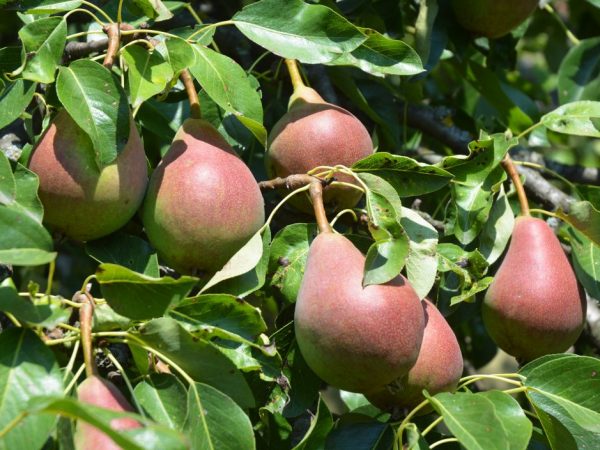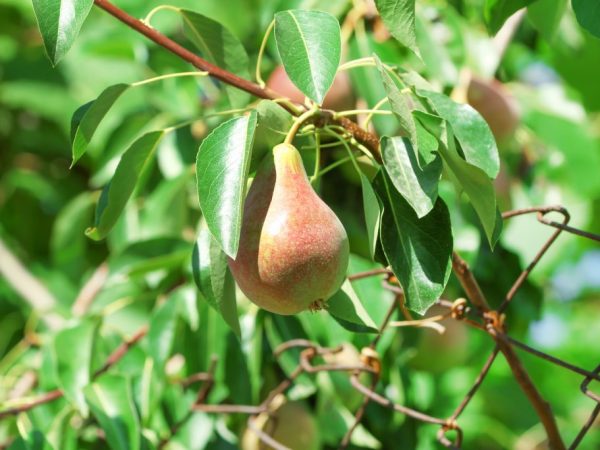Description of pear Favorite Klapp
Autumn pear Klapp's favorite is appreciated by gardeners not only for its pleasant taste, but also for the fact that it has no particular preferences in care and planting.

Description of pear Favorite Klapp
Characteristics of the variety
The Lubimitsa Klappa variety pear contains the following substances:
- sugar - 10 mg / 100 g;
- dry matter - 15%;
- vitamins of group C - 7 mg / 100 g;
- P vitamins - 40 mg / 100 g.
High levels of vitamins and minerals can enhance the human immune system.
Pear Klapp's favorite is considered universal. It is consumed fresh or used to make desserts or compotes.
The tree begins to bear fruit 5 years after planting and lives for about 50 years.
Plant appearance
The height of the pear variety Lyubimitsa Klappa reaches 4 m. The crown of a pear of medium density over time acquires a rounded shape, the main branches are at an angle of 45-50 °.
White inflorescence consists of 5-9 small flowers.
Description of the fetus
Pear variety Lyubimitsa Klappa is characterized by large fruits. The average weight of individual fruits reaches 300 g, but with the growth of the tree, the fruits decrease. An adult tree bears fruits, the weight of which does not exceed 150-170 g.
The color of the peel is represented by a pale yellow tint. As they ripen, the Lyubimitsa Klappa pear variety develops a soft pink blush, which occupies 60% of the entire fruit area. The pulp is white, the taste of the fruit is sweet, without any admixtures of acid.
Pollination process
According to the description, the Klappa's Favorite pear cannot pollinate on its own, so pollinator varieties similar to it are planted nearby.
The main pollinators are such species as Saint Germain, Williams, Beauty of the Forest or Bere. Also, these varieties are characterized by excellent yields and resistance to common diseases.
Preparing for landing
Before planting, planting material is selected. Preference is given only to seedlings that are no more than 2 years old. Old seedlings will not yield good yields.
Pay attention to the appearance of the roots. Their length should not be more than 25 cm. Also, there should be no signs of damage or disease on the root system, otherwise the plant will quickly die.
The soil should be chosen loose. It is important that it contains a minimum of acid-base balance and is characterized by a high content of nutrients. This is important for the development of the root system and the entire tree. Preference should be given to chernozem or loamy soil.
Landing rules

The tree needs to be tied up
Planting the variety Lyubimitsa Klappa is best done in the fall. During the winter, the root system will get stronger, and in the spring it will begin to form into bunches.
Dig a hole in advance with dimensions of 60 x 100 cm. A support is buried in it, where the sapling is then tied up. This allows it to form smoothly and not break under the influence of the wind.
Having spread the roots around the entire perimeter of the pit, they are gradually covered with earth.The earth must penetrate even into the space between the parts of the roots. The neck of the root system should be 4 cm above the ground. After that, the plant is completely covered and the soil is slightly tamped. The tree is immediately tied to the support. After that, a small circular hole is formed around the young tree. It is designed for irrigation.
The tree is watered immediately after planting. At least 2 buckets of water at room temperature (28-30 ° C) are poured into the formed hole. Also, water is mixed with humus, the plant is watered. This allows the roots to grab onto the soil immediately and develop better.
Care rules
It should be noted that care is the key to the correct development of any plant. It allows not only to improve the immune system of the crop, but also to significantly increase the yield indicators.
Watering
Watering must be done correctly. It is carried out in the evening with warm water so that moisture does not evaporate under the influence of the sun. The regularity of watering directly depends on the climate of the region (in hot regions, the plant is watered more often). The optimal watering regime is every 3-4 days.
Pruning
Pruning plays an important role in the grooming process. Young trees must be pruned before planting. It is recommended to delete long branches. Mature plants are pruned every year in the spring. Damaged areas, diseased or dry, are removed. This will promote the distribution of nutrients only to healthy parts.
Top dressing
Top dressing should consist of alternating organic matter and mineral fertilizers. Immediately after planting, they are fed with nitrogen for successful root development.
At the time of flowering formation, top dressing is carried out using compost or humus in order to increase the number of inflorescences, and, as a result, the yield.
During the fruiting period, fertilizing is carried out with phosphorus and potassium compounds. They allow the fruit to pour faster and acquire a pleasant taste.
Disease prevention
The autumn pear of the Lyubimitsa Klappa variety is not resistant to diseases and parasites, despite the properties of pollinators. The main diseases to which this species is exposed are scab and powdery mildew.
Prevention consists in the timely pruning of branches that are beginning to be exposed to the disease. If the moment of the formation of the disease is missed, it can be cured with a solution of Bordeaux liquid or copper sulfate. Spraying is carried out every week until the complete destruction of the disease.
Moth and aphids are the main parasites. You can prevent the appearance of parasites by treating the plant with Karbofos. In 5 liters of water, 40 mg of the drug is diluted and spraying is carried out. You can get rid of existing pests with folk remedies by preparing a tincture of chamomile or calendula.
Treatment with these substances is carried out every 2 days.
Conclusion
Clapp's favorite is one of the most common pear tree varieties. You need to follow standard care rules to get an excellent, high-quality crop.


